NEW! Stem Cells Hair Transplant No Sexual Dysfunction & Medication-Free
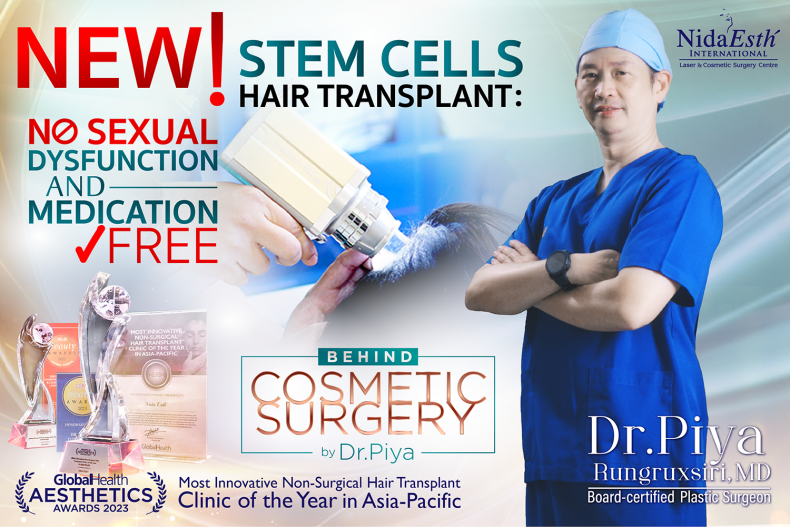
2023 Global Health Asia Pacific award winning Technique for Genetic Hair Loss and Thinning Hair Behind Cosmetic Surgery By Dr. Piya
Promote New Hair Growth at Cellular Level to Increase Hair Thickness & Hair Density
No Medication
No Sexual Dysfunction
No Surgery
No Shaving
No Downtime
To
The New Real Natural Hair Results
Welcome to our latest episode in Behind Cosmetic Surgery By Dr. Piya where we are going to answer all questions about cosmetic surgery by the expert Dr. Piya Rungruxsiri, aka ‘Dr. Piya’ - a well-recognized board-certified plastic surgeon of the International Society of Aesthetic Plastic Surgery (ISAP) from Nida Esth’ Medical Centre: the No.1 beauty destination selected as ‘the Most Innovative Non-Surgical Hair Transplant Clinic of Asia Pacific’ by Global Health Asia Pacific in 2023."
The subject of discussion today is hair loss, which is a very common concern for many individuals. Though there are various treatments available to combat this issue, Finasteride is one of the popular treatments and while it has been effective in promoting hair growth, there are some unfavorable side effects as well. So, today, we have gathered questions from every of our channel as well as patients from various countries who come to seek for the best hair loss treatment and selected the most frequently asked questions about hair loss treatments with these medication. Now, let's hear Dr. Piya's perspective as he breaks down each question so that we can better understand the side effects of finasteride itself.
“FIRSTLY, IS IT TRUE THAT FINASTERIDE HAS A LINK TOWARDS SEXUAL DYSFUNCTION IN PATIENTS TAKING THEM FOR HAIR LOSS TREATMENT?”
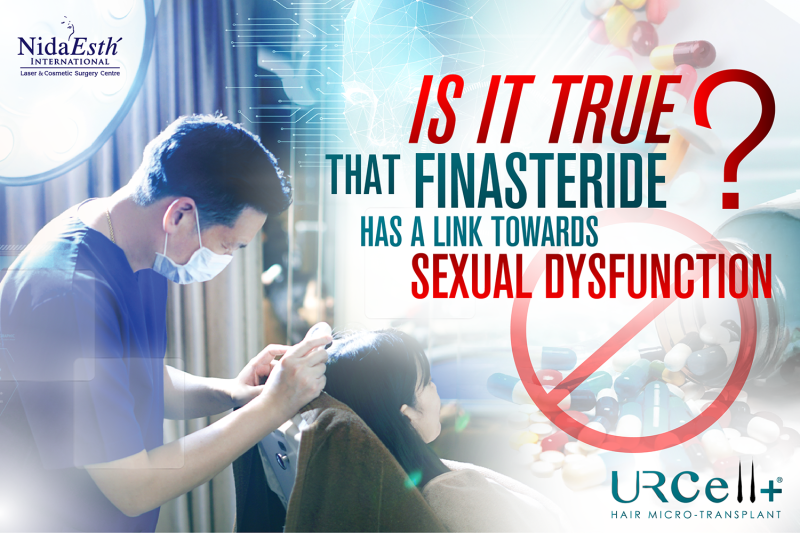
“Finasteride is undoubtedly one of the most widely used and successful treatments for hair loss on the market today. It's also one of just two FDA-approved therapies for male pattern baldness, but regrettably, studies have shown that it has real negative effects.
A 2012 research examined concerns submitted to the FDA Adverse Event Reporting System in the United States [1] and discovered instances of sexual adverse effects among 71 male finasteride-exposed individuals. In the study, it indicates that this medication has been linked to a variety of sexual side effects, including decreased sex desire, erectile dysfunction, decreased arousal, difficulty attaining orgasm, depression, and anxiety.
There are several scientifically theories as to why this happens, one of which is that the drug's vasodilatory effects reduce blood flow to the genitalia. Therefore, in 2012, the FDA formally issued a warning about its usage and side effects”
“THE SECOND QUESTION CENTERS ON HOW DO WE AVOID TAKING THESE MEDICATION AND MAINTAIN OUR TRANSPLANTED HAIR FOR A LONG TERM RESULT?”
"In my experience, this is a major concern for male patients who come to me for treatment of hair loss, which is a side effect that leads to sexual dysfunction." Most prior FUE and FUT hair transplant patients are recommended oral medicine to reduce the effects of male hormones, which are the primary cause of hair loss. These oral drugs indeed encourage hair growth, but they also cause sexual dysfunction, which is a significant concern for the majority of my male patients.
Therefore, to avoid these side effects completely, I have created the NEW hair transplant technique that requires no oral medication but still works effectively in preventing the male hormones that causes hair loss. The technique is known as UR Cell Hair MicroTransplant+ which I’ve combined the science of the European hair proliferation technique and the Japanese technique of increasing thickness that has been passed down from Prof. Dr. Fukuoka Hirotaro - a highly-respected professor among Japanese plastic surgeons who is well-known as the father of advanced cellular Hair Transplant of Japan.
This technique is a non- surgical approach and a stem-cell-based technique to regrow hair naturally without the use of Finasteride with more effective and even better results, leading to zero sexual side effect. This technique also causes neither discomfort nor scarring, effectively treating people whose hair loss is caused by genetic or hormonal factors. Many patients at Nida Esth’ discover that having this non-surgical hair transplant can help them regain a more youthful appearance, which elevates their self-confidence and general wellbeing.
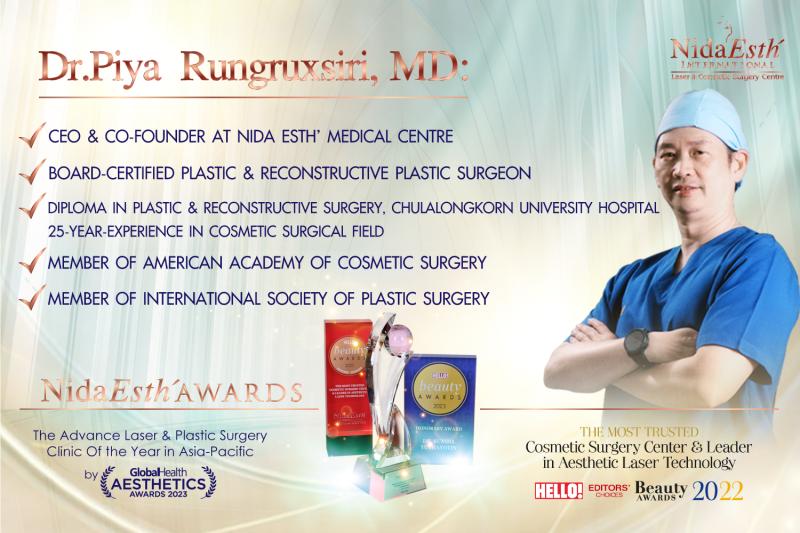
Being able to grow new hair without the need of oral medicine or surgery has sparked the interest of many patients from Thailand and other countries, who have come forward to undergo treatment in significant numbers, to the point that it has been recognized and guaranteed with a regional award the most Innovative Non-Surgical Hair Transplant Clinic of Asia Pacific by Global Health Aesthetic in 2023 and The Medical Centre Trusted for Cosmetic Surgery Results from Global Patients and the World Leader in Aesthetic Laser Technology" by Hello Magazine’s editors of Thailand in 2022.
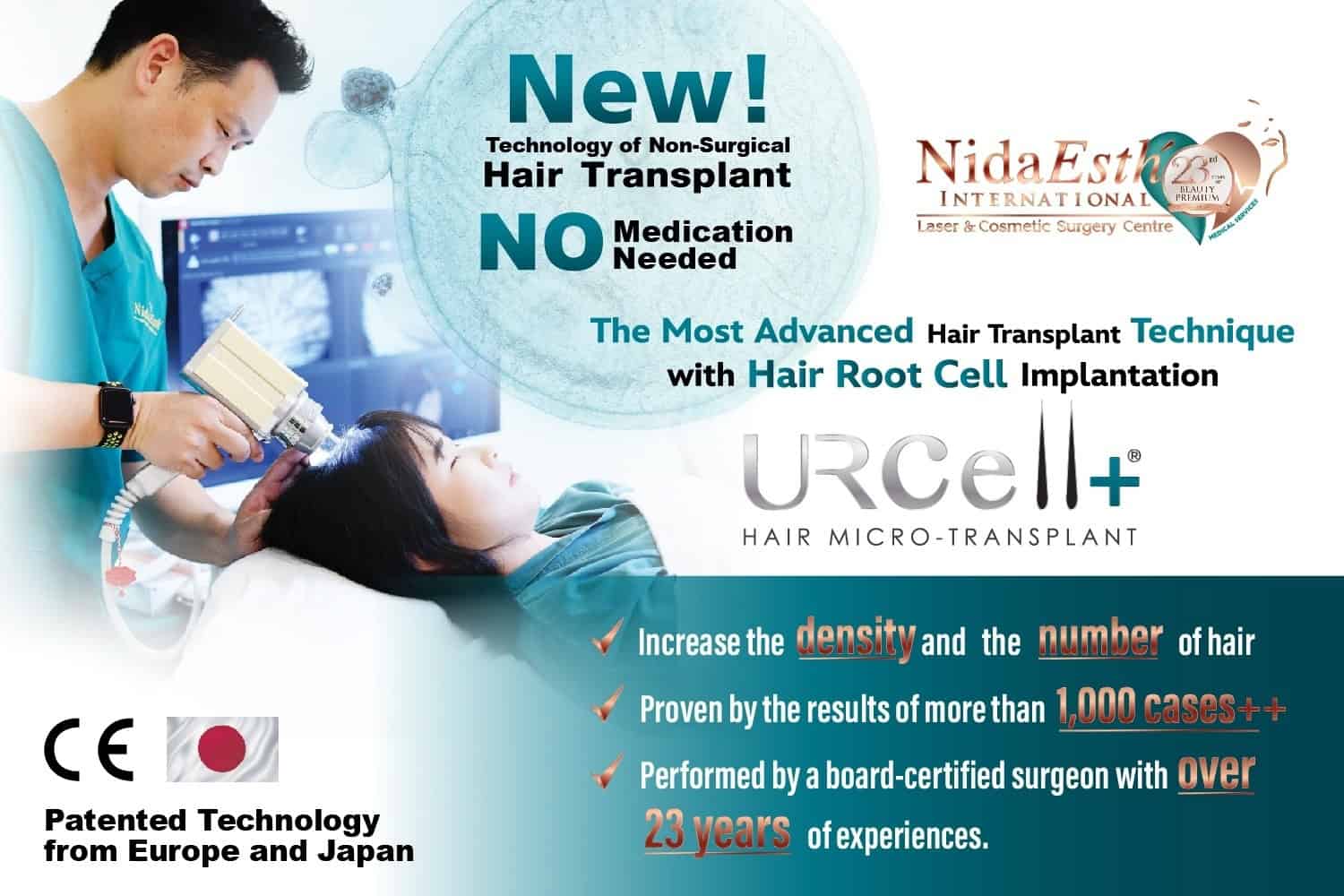
WHAT IS EXACTLY UR CELL HAIR MICRO TRANSPLANT+?
“UR Cell Hair Micro Transplant+ is a treatment program mainly using "hair follicle stem cells" derived from patients in healthy areas to extract Lived Cells to be "Micro-transplanted" in problem areas. These stem cells are responsible for resisting the testosterone hormone in problems areas, acting as a local hormonal inhibitor and a natural Finasteride; so that’s why this treatment program involves no medication at all. Additionally, the Low-Level Laser Therapy is also combined in this treatment program to regenerate atrophied hair roots to be healthy again; however, since no one comes with the same problems, each treatment program will be specifically designed and adjusted, according to each individuals’ problems to answer their concerns in the best way possible”.
“This is a new chapter in the treatment of hair loss problems caused by androgenetic alopecia (AGA) or hormones and heredity. It is a non-surgical hair transplant that produces naturally thicker hair without the use of drugs that could lead to the possibility of sexual dysfunction. Here in Thailand, this is thought to be the only cutting-edge method that combines the European science of raising hair count with the proprietary Japanese technique for boosting thickness, also known as Hair Regeneration Treatment, which is currently highly popular among those who are interested in hair transplantation” said, Dr. Piya.
HOW DOES UR CELL HAIR MICROTRANSPLANT+ WORK?
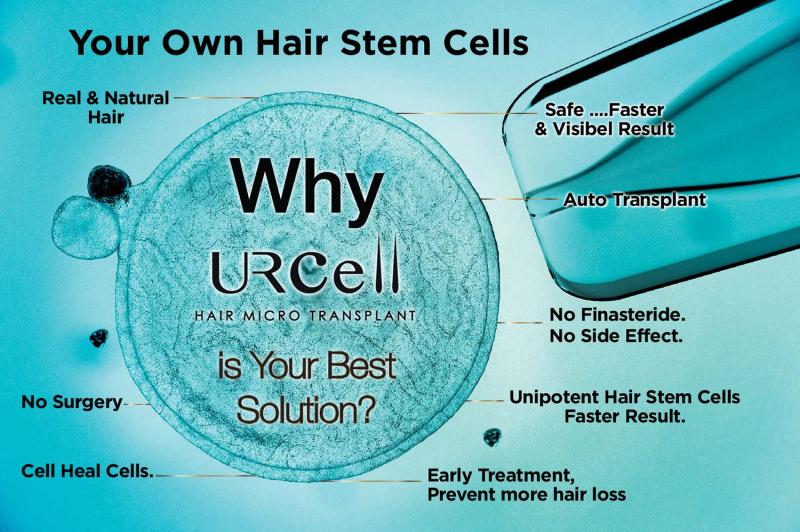
“First of all, we "harvest" the strongest hair follicles in areas that are not affected by hormones and genetics, approximately 4-5 hair roots with a special tool, only 2 mm. Then, UR Cell Hair MicroTransplant+ employs a technique to "extract" the "hair root cells" of patients with hair loss at the location where there is healthy hair left over in order to acquire living and healthy hair cells that are ready to be processed to "MicroTransplant" into the hair follicle in the problematic areas with the procedure called "Auto Transplant.”
“The extracted hair follicles act as a "Biological Factor" to protect hair follicles from the effect of male hormones which can create hair loss. “Hair Micro Transplant” process is the reparation of hair follicle cells that have been weakened by the effects of Hormone Androgenetic Alopecia (AGA) to become healthier by implanting a healthy hair follicular cells. It also adjusts the abnormal hair circuit to be normal as well. The result is new hair that grows in a normal life cycle. Also, it stimulates hair follicle cell division and gives nutrition needed for the growth of hair follicle cells” explained, Dr. Piya.
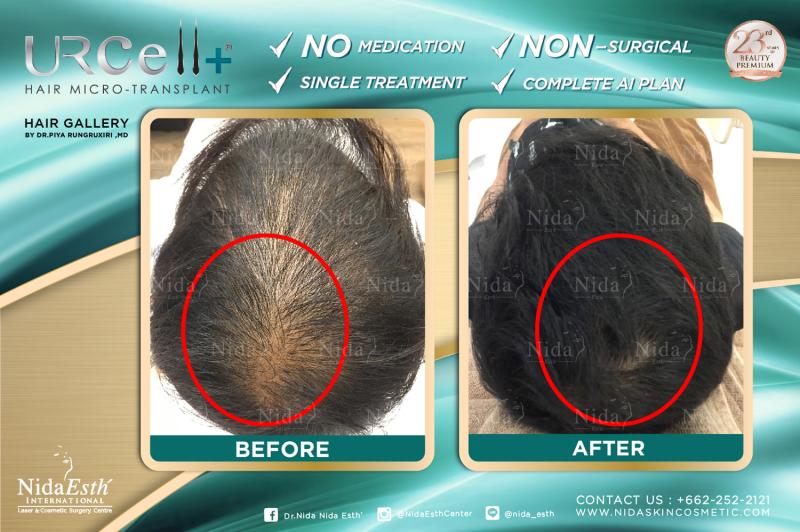

WHO IS UR CELL HAIR MICRO TRANSPLANT SUITABLE FOR?
- Those who do not want to rely on a surgical solution
- Those who are concerned about the potential negative effects of medication
- Those who do not want to shave their hair before to treatment.
- Those with mild to severe hair loss problems brought on by hormone imbalances and genetics.
TECHNOLOGY THAT GUARANTEES MEASURABLE RESULTS OF HAIR MICRO TRANSPLANT
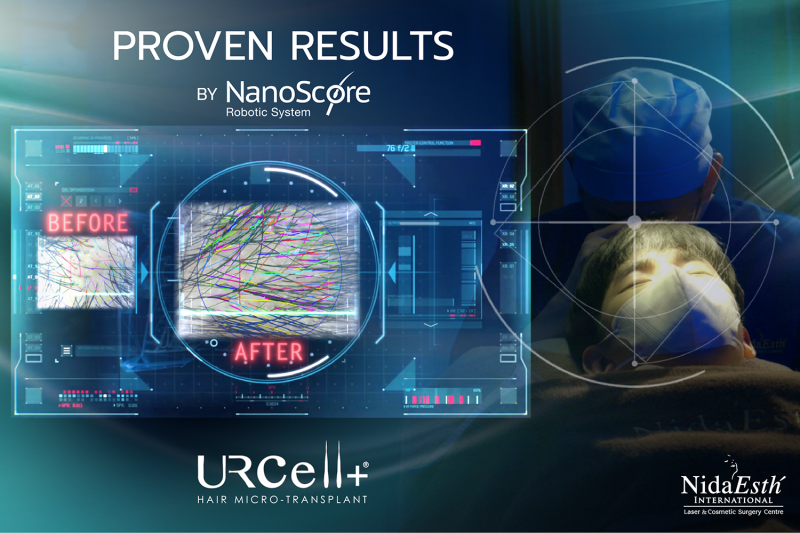
The treatment for “hair loss and thin hair problems” is a very delicate matter. Dr. Piya has therefore invested in importing the technology called Nano Score Robotic System, which is a state-of-art hair follicle scanning technology at the cellular level from Germany. It is usually not found in general hair clinics or institutions but only in national medical research centers. However, Dr. Piya willingly invested in the technology for the accurate “analysis of hair loss and thinning hair treatment”.
With the use of the Nano Score Robotic System, an amazing cellular hair measurement technology from Germany that can thoroughly examine hair and scalp at the cellular level, Nida Esth' Medical Centre is able to ensure the success of hair transplantation as it can count the number of hairs, the average overall hair density, the proportion of healthy hair, the quantity of hair roots, and the typical number of hairs in each hair follicle. As a result, it is feasible to compare the outcomes clearly and precisely before and after treatment..
………………………………………………………………………………..
Reference
1. Mysore, Venkataram. “Finasteride and sexual side effects.” Indian dermatology online journal vol. 3,1 (2012): 62-5. doi:10.4103/2229-5178.93496
………………………………………………………………………………..
Affiliated Hospitals


